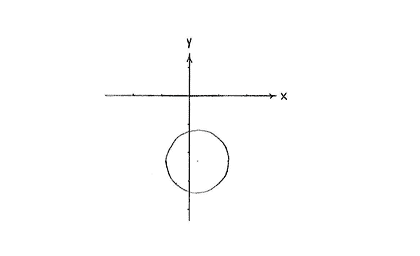Lösung 4.1:6c
Aus Online Mathematik Brückenkurs 1
K (hat „Solution 4.1:6c“ nach „Lösung 4.1:6c“ verschoben: Robot: moved page) |
|||
| Zeile 1: | Zeile 1: | ||
| - | + | Wir müssen die Gleichung des Kreises auf die Form | |
| - | + | ||
<math>\left( x-a \right)^{2}+\left( y-b \right)^{2}=r^{2}</math> | <math>\left( x-a \right)^{2}+\left( y-b \right)^{2}=r^{2}</math> | ||
| + | bringen, wo wir direkt den Mittelpunkt <math>\left( a \right.,\left. b \right)</math> und den Radius <math>r</math> ablesen können. | ||
| - | + | Wir bringen zuerst den Faktor <math>3</math> aus den Klammern heraus | |
| - | <math> | + | |
| - | + | ||
| - | + | ||
| - | + | ||
| - | + | ||
| - | + | ||
| - | + | ||
| - | + | ||
<math>\begin{align} | <math>\begin{align} | ||
| Zeile 20: | Zeile 12: | ||
\end{align}</math> | \end{align}</math> | ||
| - | + | und dividieren danach beide Seiten mit 9, und erhalten so die Gleichung | |
| - | + | ||
| - | + | ||
| - | , so | + | |
| - | + | ||
<math>\left( x-\frac{1}{3} \right)^{2}+\left( y+\frac{7}{3} \right)^{2}=\frac{10}{9}</math> | <math>\left( x-\frac{1}{3} \right)^{2}+\left( y+\frac{7}{3} \right)^{2}=\frac{10}{9}</math> | ||
| - | + | Nachdem die rechte Seite | |
<math>\left( \sqrt{\frac{10}{9}} \right)^{2}</math> | <math>\left( \sqrt{\frac{10}{9}} \right)^{2}</math> | ||
| - | + | ist, und der term | |
<math>\left( y+\frac{7}{3} \right)^{2}</math> | <math>\left( y+\frac{7}{3} \right)^{2}</math> | ||
| - | + | wie | |
<math></math> | <math></math> | ||
| + | geschrieben werden kann, erhalten wir die Gleichung | ||
| + | |||
| + | <math>\left( y-\left( -\frac{7}{3} \right) \right)^{2}</math> | ||
| - | + | Dies ist die Gleichung eines Kreises mit dem Mittelpunkt | |
<math>\left( \frac{1}{3} \right.,\left. -\frac{7}{3} \right)</math> | <math>\left( \frac{1}{3} \right.,\left. -\frac{7}{3} \right)</math> | ||
| - | + | und dem Radius | |
<math>\sqrt{\frac{10}{9}}=\frac{\sqrt{10}}{3}</math> | <math>\sqrt{\frac{10}{9}}=\frac{\sqrt{10}}{3}</math> | ||
Version vom 18:09, 2. Apr. 2009
Wir müssen die Gleichung des Kreises auf die Form
\displaystyle \left( x-a \right)^{2}+\left( y-b \right)^{2}=r^{2}
bringen, wo wir direkt den Mittelpunkt \displaystyle \left( a \right.,\left. b \right) und den Radius \displaystyle r ablesen können.
Wir bringen zuerst den Faktor \displaystyle 3 aus den Klammern heraus
\displaystyle \begin{align} & \left( 3x-1 \right)^{2}+\left( 3y+7 \right)^{2}=3^{2}\left( x-\frac{1}{3} \right)^{2}+3^{2}\left( y+\frac{7}{3} \right)^{2} \\ & =9\left( x-\frac{1}{3} \right)^{2}+9\left( y+\frac{7}{3} \right)^{2} \\ \end{align}
und dividieren danach beide Seiten mit 9, und erhalten so die Gleichung
\displaystyle \left( x-\frac{1}{3} \right)^{2}+\left( y+\frac{7}{3} \right)^{2}=\frac{10}{9}
Nachdem die rechte Seite \displaystyle \left( \sqrt{\frac{10}{9}} \right)^{2} ist, und der term \displaystyle \left( y+\frac{7}{3} \right)^{2} wie \displaystyle geschrieben werden kann, erhalten wir die Gleichung
\displaystyle \left( y-\left( -\frac{7}{3} \right) \right)^{2}
Dies ist die Gleichung eines Kreises mit dem Mittelpunkt \displaystyle \left( \frac{1}{3} \right.,\left. -\frac{7}{3} \right) und dem Radius \displaystyle \sqrt{\frac{10}{9}}=\frac{\sqrt{10}}{3}

